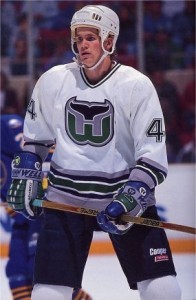
One would think that a trip to the Hockey Hall of Fame would be easy for someone of Chris Pronger’s caliber. He has won a Stanley Cup and two Olympic Gold Medals, while also adding a James Norris Memorial Trophy and a Hart Trophy to his resume. Yet, despite likely played in his last game on November 19, 2011, Pronger may not be enshrined in Toronto until 2020 at the ripe age of 46.
This is due to the structure of the Type 35-Plus section of the recently expired Collective Bargaining Agreement, which is best summed up by CapGeek:
Players who sign multi-year contracts when they are age 35 or older (calculated on June 30 of the season the contract begins) count toward the cap under all circumstances, regardless of where (or if) the player is playing. The only cap relief is $100,000 from the player’s cap hit if he is assigned to the minors after the first year of the contract (NHL Collective Bargaining Agreement, 2005, Section 50.5 d-i-B-5, p. 203).
This means that a player that has signed a contract after turning 35 can retire, but the team will still face that player’s cap-hit for each of the remaining years of his contract.
When Pronger was traded to the Flyers from Anaheim in June 2009, he signed a 7-year, $34.45 million contract extension days later at 34 years old. Because Pronger still had one year remaining on his contract he signed with Anaheim, his extension did not kick in until the following season, making him 35 when the contract went into effect. Thus, Pronger falls into the aforementioned section of the CBA.
Much like many contracts signed in the salary cap era, Pronger’s deal sees him receive most of his money early. He will make $33.40 million in his first five years, leaving just $525,000 owed to him in each of his final two years on his contract. By signing for the extra two years at the end of the contract, Pronger sees his cap-hit fall from $6.68 million to $4.90 million.
Pronger was one of the Flyers’ saving graces during their 2010 run to the Stanley Cup Finals. He gave the Flyers exactly what they needed; a reliable defenseman who could get the puck to his forwards. His 18 points and plus-5 rating was key to the Flyers’ success.
Pronger faced some injuries in the second year with the Flyers, but still posted a respectable 25 points in 50 regular season games. He remained as the team’s top defenseman when he was in the lineup.
Then, the third season took a turn for the worst.
The Flyers placed Pronger on injury reserve early in the season, after he suffered an eye injury. He came back for five games in November, but was then sidelined with knee surgery. While on injury reserve, it was discovered that Pronger was having bouts with post-concussion syndrome. The team then announced that Pronger was placed on long-term injury reserve (LTIR) in mid December.
Pronger still faces these struggles today.
Lauren Pronger, Chris’ wife, says that her husband’s situation is “very disheartening.” Fighting back tears, she told Tim Panaccio of CSN Philly about what Chris is going through.
“I think this is very, very frightening for Chris,” she said in an interview in February. “He’s been able to battle through so much and come out of it, but this is different for him. This is really tough on Chris. He wants to be out here more than anyone. This is his life, this is his passion. And this is tough.”

So what can the Flyers do to eliminate that cap-hit if Pronger can no longer play?
The answer is simple: keep him on the roster.
By continually having Pronger on LTIR, his $4.90 million cap-hit is forfeited from the Flyers’ books, allowing them to spend the money on players to replace Pronger. When looking at the evidence, it is obvious that the Flyers’ best interest is to keep Pronger on LTIR until his contract expires in 2017.
According to the Hockey Hall of Fame’s criteria, a player must be officially retired from hockey for three years before consideration into the election process.
Not only will this delay Pronger’s entrance into the Hall, but he will also forgo any dignified retirement. Fellow supreme NHL defensemen, such as Scott Niedermayer and Nicklas Lidstrom, were able to leave the game with an official press conference that put their legacies to rest in the proper way. This is something that will escape Pronger, as he could be retiring five and a half years after playing in his final NHL game.
Are you thinking that this is all hearsay and that a team would not do this to a player? Let us look at the recent past for the Philadelphia Flyers:
- Defenseman Mike Rathje last played in an NHL game on November 29, 2006 and was placed on LTIR shortly after. He was determined to be officially retired in 2010, shortly after his contract expired.
- Defenseman Derian Hatcher last played in an NHL game on May 18, 2008. He was placed on LTIR during training camp the next season and sat there all season. He announced his retirement on June 16, 2009, just a few weeks before he became an unrestricted free agent.
- Forward Blair Betts last played in an NHL game on May 6, 2011. He just saw his contract end after sitting on LTIR for the duration of 2011-12; he did not sign elsewhere over the summer.
- Famed forward Ian Laperierre last played in the Stanley Cup Final for the Flyers in 2010. He sat out all of 2010-11 and 2011-12 while on LTIR and officially announced his retirement on June 12, 2012. His contract would have also expired this summer.
Barring an amazing comeback (one that would surely earn him a Bill Masterton Trophy nomination), Pronger has likely played in his last game and will have plenty of time to prepare his retirement speech.
The only thing that may end this contract debacle is the current labor negotiations that are ongoing between the NHL and NHLPA. If the Type 35-Plus rule can be amended, Pronger may receive the retirement process he rightfully deserves.